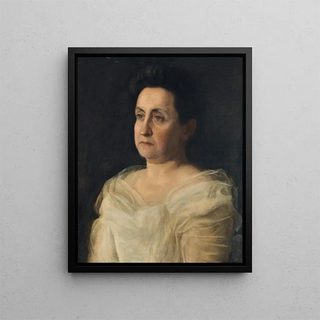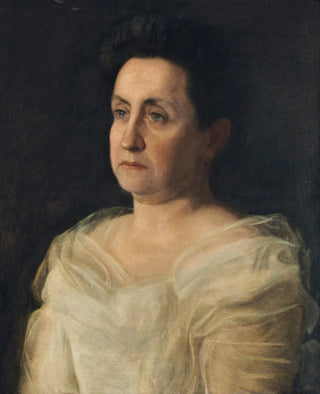Art print | Portrait of Mrs. Matilda Searight - Thomas Eakins


View from behind

Frame (optional)
The "Portrait of Mrs. Matilda Searight" by Thomas Eakins is a work that transcends mere artistic exercise to become a true exploration of human psychology. Captured in a moment of reflection, this painting invites the viewer to delve into the intimacy of the subject, a woman whose gaze appears both contemplative and determined. Through this representation, Eakins does not merely depict a female figure; he creates an atmosphere where time seems suspended, offering a glimpse into Mrs. Searight's inner world. The soft light caressing her face, along with the meticulous details of her attire, testify to the artist's technical skill and his attention to realism.
Style and uniqueness of the work
Thomas Eakins's style is distinguished by its realistic approach and his ability to capture the very essence of his subjects. In the "Portrait of Mrs. Matilda Searight," this singularity is expressed through the use of a delicate color palette and subtly orchestrated lighting. Eakins excels in representing textures, whether it be the fabrics of the dress or the nuances of the skin, thus imparting a depth and an almost tactile dimension to the piece. The composition, though classical, is animated by a dynamic that reveals psychological tension. Mrs. Searight's gaze, fixed outward, seems to question the viewer, creating an interaction that transcends the frame of the canvas. This ability to establish a visual dialogue is one of the features that make this work so memorable and timeless.
The artist and his influence
Thomas Eakins, an emblematic figure of 19th-century American art, played a decisive role in the evolution of portraiture and realistic painting. Trained in Paris, he mastered European techniques while developing a sensitivity unique to his American context. Eakins always sought to represent truth, whether through portraits, scenes of daily life, or studies of the nude. His influence is felt not only in his own work but also among many artists who succeeded him. By emphasizing the psychology of characters, he paved the way for a new understanding of painting.

Matte finish

View from behind

Frame (optional)
The "Portrait of Mrs. Matilda Searight" by Thomas Eakins is a work that transcends mere artistic exercise to become a true exploration of human psychology. Captured in a moment of reflection, this painting invites the viewer to delve into the intimacy of the subject, a woman whose gaze appears both contemplative and determined. Through this representation, Eakins does not merely depict a female figure; he creates an atmosphere where time seems suspended, offering a glimpse into Mrs. Searight's inner world. The soft light caressing her face, along with the meticulous details of her attire, testify to the artist's technical skill and his attention to realism.
Style and uniqueness of the work
Thomas Eakins's style is distinguished by its realistic approach and his ability to capture the very essence of his subjects. In the "Portrait of Mrs. Matilda Searight," this singularity is expressed through the use of a delicate color palette and subtly orchestrated lighting. Eakins excels in representing textures, whether it be the fabrics of the dress or the nuances of the skin, thus imparting a depth and an almost tactile dimension to the piece. The composition, though classical, is animated by a dynamic that reveals psychological tension. Mrs. Searight's gaze, fixed outward, seems to question the viewer, creating an interaction that transcends the frame of the canvas. This ability to establish a visual dialogue is one of the features that make this work so memorable and timeless.
The artist and his influence
Thomas Eakins, an emblematic figure of 19th-century American art, played a decisive role in the evolution of portraiture and realistic painting. Trained in Paris, he mastered European techniques while developing a sensitivity unique to his American context. Eakins always sought to represent truth, whether through portraits, scenes of daily life, or studies of the nude. His influence is felt not only in his own work but also among many artists who succeeded him. By emphasizing the psychology of characters, he paved the way for a new understanding of painting.






